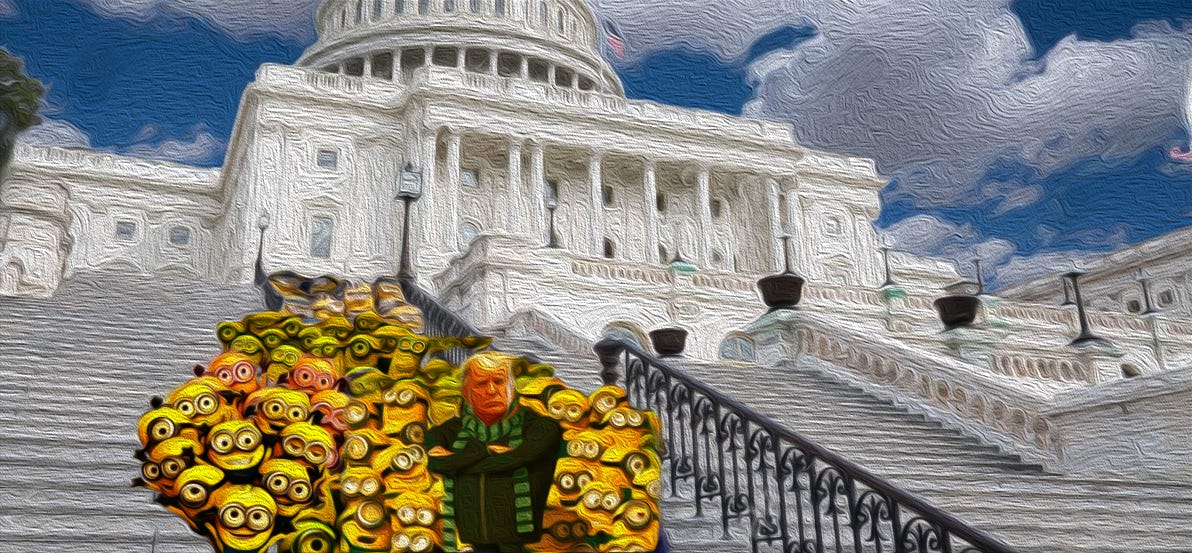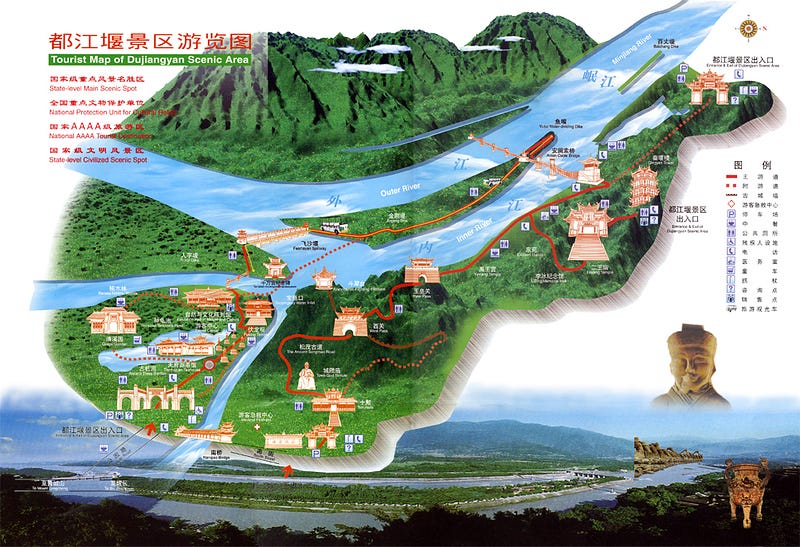The Great Pause Week 83: Permaculturing the Great American Desert
"Zhao harnessed the river not by damming it, but by dividing the water. He spread it, slowed it, sank it and stored it."
In my noir mind I am reading the part of the comic where crime boss Cobblepot from his throne room at Mar-A-Lago makes an (unrecorded) call to Kyrsten Sinema.
“How much would it take to get you to vote against the infrastructure bills?”
“I don’t know. Do you like my nails with fluorescent lime or passionfruit? Maybe I could alternate them?”
“A billion? We could get that.”
“Looking at my crypto wallet. Not moving. Not moving.”
“Done.”
“Why yes, well there it is. How nice.”
In the 30s President Franklin D. Roosevelt put tens of thousands of people to work, with hoes, wheelbarrows, and horse-drawn graders, building hundreds of miles of embankments across the Midwest, from the Sonoran Desert north to Canada. The new embankments held back the runoff from rain and allowed it to soak, dropping silt and making tree planting almost unnecessary, because passing birds did that.
Between 1930 and 1935 Franklin Roosevelt had 3 million Americans out with supervisors and engineers repairing America. It was the first time in American history, and the last time, and one of the rare times in the history of the world, that anybody in charge of a country has put the country to work to repair the damage.
— Bill Mollison, The Global Gardener: Part 2, Drylands (ABC-TV 1991).
Besides the Loess Plateau, which I described here in week 66, another example from China is the massive Dujiangyan earthworks project constructed in 256 BCE and still in use today.
Once upon a time, in the Kingdom of Min, the people were very unhappy. In spite of the fertile soils of the valley floor, life was an endless struggle to provide. No sooner was the rice ready to harvest than the Min River would rush down from the steep Western mountains, slow abruptly upon reaching the Chengdu Plain, drop its mud and make disastrous floods.
Surveying the mountain, King Zhaoxiang (秦昭襄王) devised an audacious solution. Over four years, using tens of thousands of villagers, Zhao constructed a water-diversion levee resembling a fish’s mouth, using long sausage-shaped baskets of woven bamboo filled with stones (known as zhulong) held in place by wooden tripods (known as macha). This was before gunpowder was invented, and the bronze and iron tools available at the time could not penetrate the hard rock of the mountain, so a combination of fire and water would be employed to heat and cool the rock walls until they cracked and could be removed to fashion the new river channel.
After eight years of such work, a 20-meter (66 ft)-wide channel had been gouged through the gorge, dividing the river to two sides of a central island. In this way Zhao’s engineers could allow floodwaters to escape harmlessly to one side while taming the channel on the other for irrigation.
After the system was finished, no more floods occurred. The irrigation made Sichuan the most productive agricultural region in China. The construction is also credited with giving the people of Sichuan a laid-back attitude to life and taste for spicy food. It eliminated a constant disaster, ensured a predictably bountiful harvest, and left the Kingdom of Min with plenty of free time to engage in pleasure-filled leisure.
Zhao harnessed the river not by damming it, but by dividing it. He spread it, slowed it, sank it and stored it. Millions visit the Dujiangyan fish mouth still today, to watch it renew by rain, gravity, and the weight of water as it irrigates over 2,000 square miles (5,300 km2) of high dry plains.
We know we are capable of this. Why then do we read in The New York Times of August 27 that desertification of half the continental United States is all but inevitable now? As a permaculturist I often teach by using a 5 minute excerpt from the 30 minute Drylands episode of The Global Gardener where Bill Mollison walks through some WPA/CCC swales in Arizona and describes how they have prospered, untended, for 60 years (now 90), reforesting the same desert landscape that in the 1930s had blown dark sandstorms into Washington DC.
Today those forested swales are refreshing the deep water desert aquifer for future generations. That is, among other things, one element of the Biden infrastructure plan, held hostage by 52 Cobblepot-loyal minions in the United States Senate this week. It proposes a modern Climate Conservation Corps under the auspices of Deb Haaland’s Department of Interior. Her plan:
Action #1: Promote Climate-Resilient Lands, Waters, and Cultural Resources
Outcome: Lands, waters, and cultural resources threatened by climate change are managed, protected, and/or preserved for current and future generations
Action #2: Advance Climate Equity
Outcome: Vulnerable communities disproportionately impacted by climate change have equitable access to opportunities, services, and resources.
Action #3: Transition to a Resilient Clean Energy Economy
Outcome: Climate-resilient infrastructure supports current energy and mineral resource needs and future energy needs will be increasingly met through renewable and sustainable sources.
Action #4: Support Tribal and Insular Community Resilience
Outcome: Tribes and Insular areas are provided technical and financial resources to support climate-resilient investments.
Action #5: Empower the Next Generation of Conservation and Resilience Workers
Outcome: A new generation of Americans are empowered and equipped to bolster resilience and tackle the climate crisis.
We know how to do this. The costs are vastly smaller than the benefits conferred. Nature does most of the work. All she needs is a bit of help to get started and then to be left alone.
Americans are about to face all sorts of difficult choices about how and where to live as the climate continues to heat up. States will be forced to choose which coastlines to abandon as sea levels rise, which wildfire-prone suburbs to retreat from, and which small towns cannot afford new infrastructure to protect against floods or heat. What to do in the parts of the country that are losing their essential supply of water may turn out to be the first among those choices.
— The New York Times, August 27, 2021
_______________________________
The COVID-19 pandemic has destroyed lives, livelihoods, and economies. But it has not slowed down climate change, which presents an existential threat to all life, humans included. The warnings could not be stronger: temperatures and fires are breaking records, greenhouse gas levels keep climbing, sea level is rising, and natural disasters are upsizing.As the world confronts the pandemic and emerges into recovery, there is growing recognition that the recovery must be a pathway to a new carbon economy, one that goes beyond zero emissions and runs the industrial carbon cycle backwards — taking CO2 from the atmosphere and ocean, turning it into coal and oil, and burying it in the ground. The triple bottom line of this new economy is antifragility, regeneration, and resilience.
Help me get my blog posted every week. All Patreon donations and Blogger subscriptions are needed and welcomed. You are how we make this happen. Your contributions are being made to Global Village Institute, a tax-deductible 501(c)(3) charity. PowerUp! donors on Patreon get an autographed book off each first press run. Please help if you can.
#GenerationRestoration
“There are the good tipping points, the tipping points in public consciousness when it comes to addressing this crisis, and I think we are very close to that.”
— Climate Scientist Michael Mann, January 13, 2021.
Want to help make a difference while you shop in the Amazon app, at no extra cost to you? Simply follow the instructions below to select “Global Village Institute” as your charity and activate AmazonSmile in the app. They’ll donate a portion of your eligible purchases to us.
How it works:
1. Open the Amazon app on your phone
2. Select the main menu (=) & tap on “AmazonSmile” within Programs & Features
3. Select “Global Village Institute” as your charity
4. Follow the on-screen instructions to activate AmazonSmile in the mobile app





Comments
By the way, the DNC seriously discouraged a progressive challenger to Manchin last year.
What do I mean about taking their promises seriously? Here's an example: when Dems controlled the California legislature but Schwarznegger was governor, they passed a "Californiacare" universal health coverage plan multiple times, knowing he would veto it, but it would score points with their constituents. Now that they've got a Democratic governor, the Californiacare bill has languished in committee, until just recently, when a progressive Dem tried to bring it to a vote, only to back down when he realized that not enough Democrats would vote for it to pass it, because private health care money.
Technofix hope peddlers, Democrats....Albert, I'm worried about you.Great story about the Chinese project, though.
Backing the Blues to beat the Reds has some benefits. We have Deb Haaland at Interior, which is historic. President Romney may replace her with Liz Cheney, so we should seize this opportunity while we have it to end oil and uranium leases, build health clinics on reservations, and stop deforestation. These seem like pitifully small gains when a revolution is required, but that is why I hold my nose and support Democrats. Pragmatism.